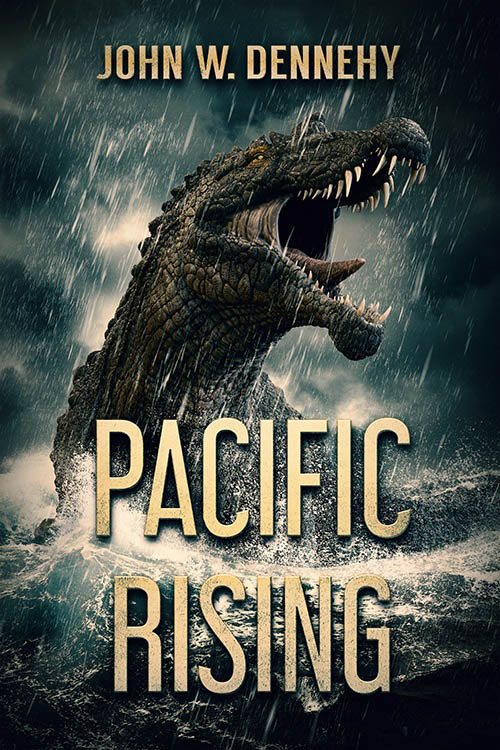Pacific Rising
John Dennehy
2017
Severed Press
Reviewed by Michael R. Collings
Many, if not most, ‘creature features’—be they in print or film—are less about the monsters than about the humans combatting them. The monster provides a backdrop for exploring human motivations and potentials: heroism and cowardice, idealism and practicality, the conflicting powers of love and fear. At their most effective, the monsters are carefully crafted to highlight human strengths and weaknesses, while themselves retaining a high degree of individuality and accessibility. At their least effective, they threaten to become interchangeable place-holders.
The Kaiju of Japanese tradition provide an ideal instance of the potential force of monsters. The perennial interest in Godzilla, perhaps the prime example, indicates that the image can become a powerful image, not only within the culture that spawned it (pun intended) but for the world at large. As metaphor, symbol, type of the awesome and ill-defined power of atomic energy, the Kaiju rises from the mysterious depths of the ocean to wreak unspeakable havoc until turned back by some form of the atomic power that gave it life—and by the sheer heroism of a handful of men and women willing to sacrifice their all to save the many.
John W. Dennehy’s Pacific Rising effectively illustrates these ideas. It has a monster, a Kaiju—Zamera—that had risen in 1965 to lay waste to Tokyo until trapped in a deep-sea crevice by a small nuclear detonation. Now it has been awakened by a devastating hurricane and returns to take its revenge on the city and the nation that had earlier defeated it…and to sate its hunger for human flesh.
General Yoshi and the Japanese Self-Defense Forces prove unable to halt its march of destruction, so it falls to the United States military to assist. Enter Master Gunnery Sergeant James Penton, the highest-ranking enlisted Marine on Okinawa, to oversee preparations for an air strike against Zamera. And with him enters the underlying hero of Pacific Rising, as abstract and as individualized as Zamera itself: the United States Marine. In part, Dennehy honors the entire service, but more crucially, he focuses on the individual Marine who, in the face of horrific opposition, stands firm, performs the assigned task, and, if necessary, dies doing so. In one subplot after another, a generalized battle plan—whether it entail Harriers converging on Tokyo or stealing a North Korean nuclear bomb (earlier stolen from the Russians)—Dennehy rapidly compresses the action to single individuals and follows their unique paths until the mission is accomplished and the Kaiju destroyed.
The rise of Zamera and its initial attack on Tokyo are accomplished in four pages through a series of action clips almost kaleidoscopic in intensity and effect; preparing and loading the ordnance for the Harriers, on the other hand, takes far longer and is defined in much more intricate detail. That Penton per se oversees those preparations is in some respects irrelevant. The implication is that any Marine would have done the same. And the fact that plot twists place Penton and fellow Marine Kate Able alone in the final confrontation with the monster in a sure-death situation is equally tangential; although they are in their own way fully realized, they are as much types, symbols, and metaphors for those who serve as the Kaiju is of the monstrum that emerges from the darkness and threatens the light. Pacific Rising is a paean to preparation, to service, to honor.
The novel will resonate most fully with readers interested in military-based horror, for whom the various acronyms liberally incorporated into the story are intrinsically meaningful. The minutiae of ordnance and preparation, of military planning and execution, balances in small the power of the sixty-foot-tall monster destroying a multi-story building in its mindless quest for a single Marine—and both perspectives are crucial to Pacific Rising.
The novel suffers from some technical difficulties; it tends toward redundancy and awkwardness in word choice, and minor characters often remain more stereotypes than individuals. But on the whole it accomplishes what it set out to do: resurrect an emblematic antagonist and demonstrate how modern weaponry wielded by heroic individuals can defeat the undefeatable.









